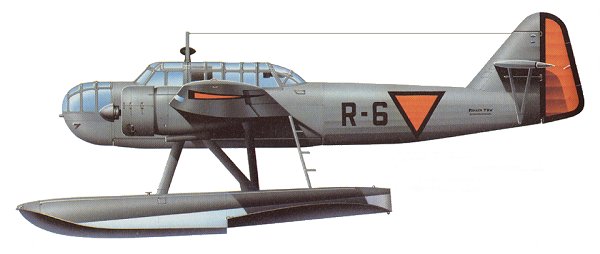- Fokker T.VIII
infobox Aircraft
name = T.VIII
type = Torpedo-bomber seaplane
manufacturer =Fokker 
caption =
designer =
first flight = 1938
introduction =
retired =
status =
primary user =Dutch Naval Aviation Service
more users =Royal Air Force Luftwaffe
produced =
number built = 36
unit cost =
developed from =
variants with their own articles =The Fokker T.VIII was a Dutch twin-engined torpedo-bomber and reconnaissance floatplane developed in the late 1930s, which served in the Dutch, British and German air forces. The aircraft was originally developed as a result of a request from the Dutch Naval Aviation Service for an aircraft for use in home waters and in theDutch East Indies .Development
The T.VIII W/G was a mid-winged monoplane with a three-part fuselage of oval cross-section which consisted of a light alloy nose, a centre section of wood and a tail of steel frame with a fabric covering. The wing was constructed with two cross-beams with
bakelite ribs and clad inplywood . In the T.VIII W/M variant the tail, as well as the wings, were constructed from light alloy. The undercarriage consisted of two floats of rustproofDuralumin with six waterproof compartments and a reserve fuel tank in each.Operational history
The aircraft went into production after the first flight in 1938 and eleven entered Dutch service. At the time of the German invasion in 1940, nine aircraft relocated to bases in France, and on 22 May 1940 escaped to the UK to form the basis of No. 320 (Dutch) Squadron RAF,
Coastal Command , based atPembroke Dock in South Wales. Eventually lack of spares meant that these aircraft were retired. Meanwhile, the Germans completed the T.VIII's, still under construction at the Fokker factory, and after evaluation atTravemünde , operated them in theNorth Sea in the reconnaissance, air-sea rescue and anti-submarine role. In May 1941, Dutch Lieutenant Beelaerts van Blokland, together with pilot Govert Steen, Fokker technician Lindeman and resistance fighter Boomsma, stole a T. VIIIW in German service floating in the Amsterdam IJ and flew it to England to join the Allied forces.Variants
;T.VIII W/G:Mixed wood and metal construction. 19 built.;T.VIII W/M:All-metal construction. 12 built.;T.VIII W/C:Larger version with more powerful engines. Five had been ordered by Finland, but were captured and used by the Luftwaffe.
Operators
;FIN
*Finnish Air Force ordered 5 T.VIII W/C but none were delivered.;flag|Germany|Nazi
*Luftwaffe operated several captured aircraft.;NLD
*Dutch Naval Aviation Service ;UK
*Royal Air Force pecifications (T.VIII W/G)
aircraft specifications
plane or copter?= plane
jet or prop?= prop
ref=Encyclopedia of Military Aircraft [Jackson, Robert, "The Encyclopedia of Military Aircraft", Paragon, 2002. ISBN 0-75258-130-9]
crew= Three
capacity=
length main= 13.0 m
length alt= 42 ft 7 in
span main= 18.0 m
span alt= 59 ft 0 in
height main= 5.0 m
height alt= 16 ft 4 in
area main=
area alt=
airfoil=
empty weight main=
empty weight alt=
loaded weight main= 5,000 kg
loaded weight alt= 11,023 lb
useful load main=
useful load alt=
max takeoff weight main=
max takeoff weight alt=
more general=
engine (prop)=Wright Whirlwind R-975-E3
type of prop=9-cylinderradial engine s
number of props=2
power main= 336 kW
power alt= 450 hp
power original=
max speed main= 285 km/h
max speed alt= 154 knots, 177 mph
max speed more=at 3,000 m (9,845 ft)
cruise speed main=
cruise speed alt=
never exceed speed main=
never exceed speed alt=
stall speed main=
stall speed alt=
range main= 2,750 km
range alt= 1,485 nm, 1,709 mi
ceiling main=
ceiling alt=
climb rate main=
climb rate alt=
loading main=
loading alt=
thrust/weight=
power/mass main=
power/mass alt=
more performance=
armament=
* 2 × 7.92 (0.31 in) machine guns
* 600 kg (1,323 lb) of bombs or torpedoes
avionics=References
Notes
Bibliography
* Green, William. "War Planes of the Second World War: Floatplanes (vol. 6)". London: Macdonald & Co., (Publishers)Ltd., 1962
* Van der Klaauw, Bart. "The Fokker T.VII (Aircraft in Profile number 176)". Leatherhead, Surrey, UK: Profile Publications Ltd., 1967. No ISBN.
* _______________. "Water- en Transport Vliegtuigen Wereldoorlog II". Alkmaar, the Netherlands: Uitgeverij de Alk bv, year unknown. ISBN 90-6013-6772. (in Dutch)ee also
aircontent
related=similar aircraft=
sequence=
lists=
*List of military aircraft of Germany
*List of aircraft of the RAF
*List of seaplanes and flying boats
see also=
Wikimedia Foundation. 2010.
